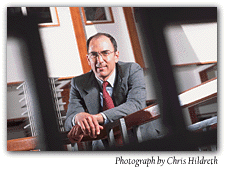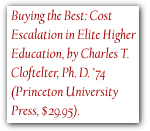Main Menu · Search ·Current Issue ·Contact ·Archives ·Centennial ·Letters to the Editor ·FAQs
| Unbounded Aspirations | Films: The West |
| Music: Trout, Enjoying Opera | Chapter & Verse |
| Off the Shelf | Open Book |


Pass by any newsstand and chances are at least one weekly magazine will flaunt banner headlines denouncing the soaring cost of college and bemoaning the plight of students and parents who must pay these horrendous prices, or forgo college altogether. Never mind that more than 60 percent of undergraduates pay less than $3,000 a year in tuition, or that only 8 percent pay more than $12,000-the obsession in the media is with that tiny number of elite colleges that charge, as Newsweek so delicately put it in its April 29, 1996, issue, $1,000 per week. With all the journalistic furor and misinformation surrounding this important topic, Charles Clotfelter's Buying the Best stands out as a sober, detailed, and clear-headed look at the forces driving up costs at four elite private institutions: Harvard, Duke, Chicago, and Carleton College.
Clotfelter, an economist and former vice provost at Duke, had the cooperation of all four institutions and was given access to detailed financial and educational records not generally available. He set out to answer the same question that motivates journalists, parents, students, legislators, pundits, and policy analysts-why have college costs risen considerably faster than the consumer price index or median family incomes in the last 10 to 15 years? (Harvard Magazine readers learned in the May-June issue that tuition, room, and board expenses at Harvard passed $10,000 in fiscal 1982, $20,000 in fiscal 1991, and will very likely pass $30,000 in fiscal 1998.) Although Clotfelter's small sample is hardly representative of American higher education, the insights gained by his close look at these four cases provide answers that escape those who examine larger, but less fine-grained, sets of data.
Because Clotfelter focused on undergraduate costs in the arts and sciences, he excluded data on professional schools. He tried to gather comparable data for the academic years 1976-77, 1981-82, 1986-87, and 1991-92. For certain analyses of average class size, allocation of faculty effort, and number of course offerings, he examined data for representative departments in the humanities, social sciences, and natural sciences. He focused on direct educational expenditures, and so excluded costs for "auxiliary enterprises," such as medical centers and college dormitories. He paid particular attention to the spending of unrestricted funds (tuition, annual gifts, some endowment earnings), because administrators have greater discretion in their use, making these outlays a good indicator of institutional priorities. Much of this is pioneering analysis, but fear not: Clotfelter writes clearly and generally avoids jargon-the book is highly readable.
 The analysis begins by tracking patterns and trends in expenditures at each institution during the 1980s. By 1991-92, Duke was spending $162 million on arts and sciences, Harvard $379 million, Chicago $247 million, and Carleton $43 million. During the 1980s, after adjusting for inflation, the average annual rates of spending growth were 6.8 percent at Duke, 5.3 percent at Harvard, 6.0 percent at Chicago, and 5.7 percent at Carleton. These growth rates roughly equal average annual increases in tuition during those years, adjusted for inflation. But how was the money spent?
The analysis begins by tracking patterns and trends in expenditures at each institution during the 1980s. By 1991-92, Duke was spending $162 million on arts and sciences, Harvard $379 million, Chicago $247 million, and Carleton $43 million. During the 1980s, after adjusting for inflation, the average annual rates of spending growth were 6.8 percent at Duke, 5.3 percent at Harvard, 6.0 percent at Chicago, and 5.7 percent at Carleton. These growth rates roughly equal average annual increases in tuition during those years, adjusted for inflation. But how was the money spent?
Clotfelter's attempt to answer that question concludes with one of the central puzzles-and disappointments-of the book. He sensibly tries to allocate the increased spending among its possible uses-changes in market prices of labor and materials, growth in numbers of faculty and staff, increased fringe benefits, growth in financial aid, increased administrative spending-but discovers that much of the increase remains unexplained. The accounting allocations leave unexplained 38 percent at Duke, 64 percent at Harvard, 40 percent at Chicago, and 56 percent at Carleton. Much of the rest of the book is a series of attempts to identify the "missing expenditures," but that effort is less than successful. Clotfelter suggests that the residuals may reflect increased quality of service, new activities undertaken in existing units, or increased internal financing of research activities previously supported by Washington. For such a central part of the analysis to remain open to speculation, however, is unfortunate and perplexing.
That shortcoming aside, Clotfelter has assembled much useful information on administrative functions, changes in the allocation of faculty effort, and classes and course offerings.
Buying the Best examines in detail changes in the schools' administration, including, most dramatically, the growth of new functions in student services and in cost accounting and sponsored programs. These changes were driven largely by constituent demand-from students in the first case, from regulatory and outside funding agencies in the second. Clotfelter demonstrates that the enormous increase in use of personal computers has not yet led to cost reduction, but rather to an upgrading of the professional skills of staff members and, presumably, to higher quality output.
Turning to the allocation of faculty time and effort, he documents over the course of his 15-year timespan a reduction in teaching in the representative department examined within each discipline. For regular-rank faculty (those holding tenured or tenure-track appointments), teaching loads in the representative humanities department at Duke fell from 5.6 courses in the 1976-77 academic year to 4.2 in 1991-92; from 4.3 courses to 3.6 in the social sciences department; and from 3.4 courses to 2.5 in the natural sciences department. (Teaching loads measured by undergraduate students enrolled also tended to decline, while Duke's graduate enrollments increased over these years.) At Harvard, in the departments reviewed, the course load in humanities remained stable at 2.8 per year, but declined in social sciences from 3.6 to 2.5, and in natural sciences from 1.7 to 1.6. Chicago's experience was similar, and the teaching load declined at Carleton, too, but from much higher levels: 7.3 to 6.8 in humanities, 9.7 to 5.7 in social sciences, and 6.8 to 4.8 in natural sciences. Time spent advising students and doing committee work also generally declined over these years. Without providing data, Clotfelter says the freed-up time was devoted to increased research.
His analysis of average undergraduate class size and percentage of classes taught by regular-rank faculty reveals striking differences among the four schools. By the 1991-92 academic year, for example, the average class size in the social science department was 80 at Duke, 242 at Harvard, 38 at Chicago, and 24 at Carleton. At Duke, 72 percent of courses in that discipline were taught by regular-rank faculty, compared to only 48 percent at Harvard and 42 percent at Chicago; Carleton again stands alone, at 85 percent. Clearly, we see here-in four institutions that compete for similar students and charge similar prices-very different ways of educating undergraduates. Were this almost any other type of market, one would think the circumstance odd.
In attempting to make sense of what he has found, Clotfelter concludes that expenditures at-and the resultant cost to attend-these institutions rose for four reasons: the unbounded aspirations of elite institutions; the nature of competition among them; a surge in demand for elite higher education; and a variety of uncontrollable factors.
The first two causes are closely related-these institutions strive for excellence, and excellence knows no bounds, particularly in the competition for superb faculty and students. One way to attract and keep prestigious faculty members has been to lower teaching loads and maximize the time and opportunity for research. Even Carleton is not immune to such pressures, for the elite colleges also seek to attract young faculty from the best graduate schools, most of whom seek a working environment not unlike that found in the university. One way to attract and retain high quality undergraduates is to spend heavily on financial aid, so that cost need not deter any student whom the university seeks to enroll.
Add in the third factor-the surge in demand for elite higher education-and the stage was clearly set for an era of sharply rising tuition. Higher prices simply did not result in reduced applications-quite the contrary. And finally, exacerbating matters, come the uncontrollables, those increased costs universities could not avoid, including rising salaries for professional staff members, spending on new electronic technologies, and the decision to maintain research activities following a reduction in federal support.
Clotfelter closes by warning that perhaps this state of affairs cannot continue. Society may not remain willing to provide the financial support to meet such rising costs. The trade-off between teaching and research may finally have to be faced. And universities may have to scale back their ambitions to be the best in all fields.
Wise words indeed, but there is much he does not say that others will surely volunteer. If we return to our newsstands, with their headlines about rising college costs, can we expect this study to change (and improve) the nature of the public discourse?
Alas, I fear not, although this is not a criticism of Buying the Best. The fact is that Clotfelter has put hard numbers to many of the critics' accusations, replacing their anecdotes with evidence. Teaching loads in elite institutions have fallen, administration has increased, average class sizes for undergraduates are large and rising, much undergraduate teaching is done by graduate students or other irregular faculty, research does take precedence over teaching, and on and on. Tuitions have gone up largely because that was what the market would bear-even if the money was spent for worthy purposes. It is unclear whether economic or social forces will bring these steadily rising costs and prices to a halt, nor is Clotfelter given to pyrotechnics in portraying the collision of the universities' limitless aspirations with an era of "tightening of constraints." But this much is clear: nothing in his book will staunch the flow of public criticism.
The dramatic difference in the forms of education delivery at small colleges such as Carleton and universities such as Harvard, so well documented here, should also give readers pause. Clotfelter's data strongly suggest the presence of cross-subsidy from undergraduate to graduate education in the American university. In other words, we support graduate education in part on the backs of undergraduates, who pay for it through large classes and limited access to senior faculty. The university is an effective vehicle for this type of cross-subsidy, but we might also wish, perhaps vainly, that our nation could face the high costs of graduate education squarely, rather than shifting those costs to other consumers of university services. As tuition prices continue to mount, one suspects that even elite universities will come under increasing pressure to allocate more faculty time and energy to undergraduate education. Depending upon one's values, that might not be all bad.